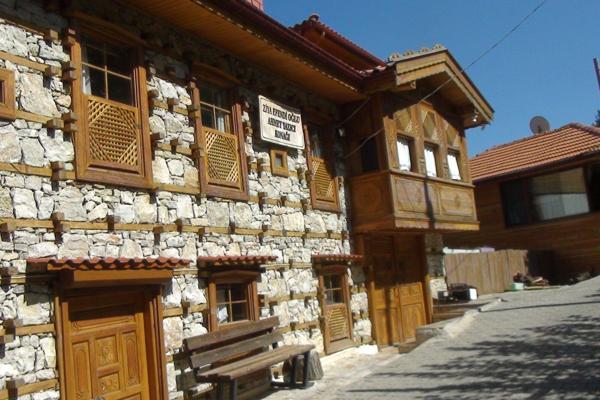Historic ‘buttoned houses’ in Antalya under restoration
ANTALYA


Famous for their distinctive architectural style, the historic "buttoned [düğmeli] houses," a popular spot among tourists in the southern province of Antalya, are undergoing restoration to preserve their original charm and will soon welcome visitors once again.
Located in the İbradı district’s Ormana and Ürünlü neighborhoods, the 300-400-year-old buttoned houses are being restored as part of a project, titled “Regulation on Providing Aid for Immovable Cultural Assets,” supported by the Culture and Tourism Ministry.
This year, a total of six buttoned houses, two in İbradı, two in Ormana, and two in Ürünlü, will be restored, while the ministry will provide a total grant of 7.4 million Turkish liras for these restorations.
The intensive restoration work is being carried out to preserve the historical essence of the buildings. The projects aim to attract not only history enthusiasts but also contribute to the region's tourism.
The buttoned houses, with their distinctive architecture, are unique to the İbradı and Akseki districts of Antalya. These structures, built with cedar wood and interlocking wooden beams, are found only in this region.
Associate Professor Ali Akın Akyol, a faculty member of the Department of Conservation and Restoration of Cultural Properties at the Ankara Hacı Bayram Veli University, emphasizes the skillfully selected and expertly applied building materials as the most significant feature of these traditional houses.
“The buildings consist of stone, mortar, tiles and magnificent woodwork. Ormana in İbradı and Akseki have a significant identity. The group of houses known as 'Buttoned Houses' has survived to our time, preserved in these areas,” he said.
Akyol pointed out that the architectural features and materials of the buttoned houses have not been thoroughly studied in academic literature.
“We discovered that buttoned houses only exist in the Akseki and İbradı regions. In terms of materials, the choice of wood for walls, ceilings and bay windows is crucial. With scientific studies, we aim to uncover the technical history of buttoned houses,” he added.
Selami Bayram Bozkurt, a local restorer, explained that he learned the trade from his father at a young age and has been restoring buttoned houses for 30 years.
"My job is to restore old houses and breathe new life into them so they can stand for another 200-300 years. In the center of İbradı, there are 29 buttoned houses, 49 out of 300 buttoned houses are in the Ormana neighborhood, and 29 registered buttoned houses are in the Ürünlü neighborhood. The youngest of these buttoned houses is approximately 200 years old. Depending on the condition and size of the houses, the ministry provides grants ranging from 1.75 million to 2.5 million Turkish liras. The Culture and Tourism Ministry provides grant support for restoring these registered buildings. Depending on the condition and size of the house, grants range from 1.75 million to 2.5 million Turkish liras," he said.
Restoring these houses is a meticulous process, according to Bozkurt. “Restoration is not an easy job; it has many fine details. Sometimes it takes a year, sometimes two years. We can’t find many skilled workers for this trade and few are interested in it. I am the third generation in my family.”
Bozkurt emphasized that the roof is the most critical element in preventing the collapse of buttoned houses. “The roof is the backbone of the house. If it isn't maintained, and tiles aren’t replaced, the roof starts to leak, leading to the eventual collapse of the house. If the roof remains intact, these houses can last not just 300 but 500 years or more,” he explained.
İhsan Tolay, who is restoring a buttoned house inherited from his father in Ormana, also pointed out that disputes among heirs are a major reason for the decay of buttoned houses.
“Many of the original owners of these houses have passed away, and disputes among heirs have left some houses neglected,” he added.
